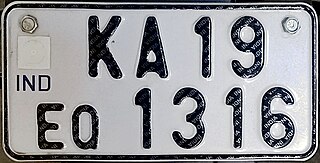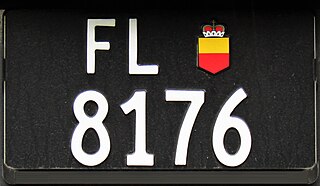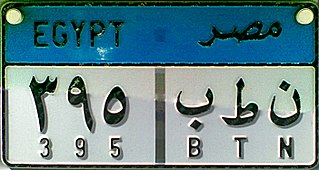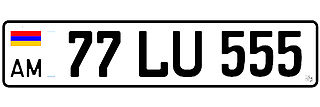
A vehicle registration plate, also known as a number plate or license plate, is a metal or plastic plate attached to a motor vehicle or trailer for official identification purposes. All countries require registration plates for road vehicles such as cars, trucks, and motorcycles. Whether they are required for other vehicles, such as bicycles, boats, or tractors, may vary by jurisdiction. The registration identifier is a numeric or alphanumeric ID that uniquely identifies the vehicle or vehicle owner within the issuing region's vehicle register. In some countries, the identifier is unique within the entire country, while in others it is unique within a state or province. Whether the identifier is associated with a vehicle or a person also varies by issuing agency. There are also electronic license plates.

Motorized vehicles in Indonesia are required to have registration plates, which must be displayed both at the front and back of the vehicles. The issuing of number plates is regulated and administered by SAMSAT, which is a collaboration between the Indonesian National Police, provincial offices of regional revenue, and the national mandatory vehicle insurance operator Jasa Raharja.
Australian vehicle registration plates or number plates are issued by state, territory, and Commonwealth governments, and the armed forces of Australia. The plates are associated with a vehicle and are generally intended to last for the time the vehicle remains registered in the state, though as they become unreadable they may be remade with like for like replacement. Motor vehicle registration in Australia can be renewed monthly, quarterly, half yearly or annually depending on the state or territory where the vehicle is registered.
The most common format for vehicle registration plates in Romania consists of black letters on white background in the format CC 12 ABC, where CC is a two letter county code, 12 is a two digit group, and ABC is a three letter group. For Bucharest, the format is B 12 ABC or B 123 ABC, where B is code for Bucharest city, 12 and 123 is a two or three digit group, and ABC is a three letter group. The left side of the plate bears a blue vertical strip displaying the 12 stars of the European Union and the country code of Romania (RO). Between 1992-2007 the band featured the Romanian flag instead of the 12 stars. All lettering comes from the Latin alphabet.

All motorised road vehicles in India are tagged with a registration or licence number. The Vehicle registration plate is issued by the district-level Regional Transport Office (RTO) of respective states — the main authority on road matters. The number plates are placed in the front and back of the vehicle. Motorbikes have a small square type registration plate in the rear while cars get a full longer number plate in the rear. By law, all plates are required to be in modern Arabic numerals with Latin letters. The international vehicle registration code for India is IND.
Vehicle registration plates of Poland indicate the region of registration of the vehicle given the number plate.

Since Ukraine's independence in 1991, the country has used four main systems of vehicle registration plates.

Thailand's vehicle registration plates are issued by the Department of Land Transport (DLT) of the Ministry of Transport. They must be displayed on all motorized road vehicles, as required by the Motor Vehicle Act, B.E. 2522 and the Land Transport Act, B.E. 2522. The plates vary in design, colors and dimensions according to the type of vehicle, but usually display a registration number and the vehicle's province of registration. Specifications are given in Ministry of Transport regulations. Current style started in 1975 for most vehicle types, but with small changes in 1997, and 1997 for motorcycles.
Vehicle registration plates of Canada, also known as licence plates, are issued by provincial or territorial government agencies. Registration plates in Canada are typically attached to motor vehicles or trailers for official identification purposes. Some Canadian registration plates have unique designs, shapes, and slogans related to the issuing jurisdiction. For example, registration plates issued in the Northwest Territories are shaped like a polar bear. In Alberta, registration plates typically display the words "Wild Rose Country."

The Canadian province of Ontario first required its residents to register their motor vehicles in 1903. Registrants provided their own licence plates for display until 1911, when the province began to issue plates. Plates are currently issued by the Ministry of Transportation of Ontario (MTO). The location of plates is specified by the Highway Traffic Act and Regulation 628 under the Act.

The Canadian province of British Columbia first required its residents to register their motor vehicles in 1904. Registrants provided their own licence plates for display until 1913, when the province began to issue plates.

Vehicle registration plates of the Principality of Liechtenstein are composed of the letters FL, followed by the small version of the coat of arms of Liechtenstein and up to five digits. The letters FL stand for Fürstentum Liechtenstein. Standard license plates show white characters on a black background, using the same type of font as Swiss license plates.
Philippine vehicle registration plates have a long history. The earliest license plates were introduced around 1912 with the introduction of Legislative Act No. 2159.

License plates are displayed on all motorized road vehicles in Brunei, as required by law. The issue of license plates is regulated and administered by the Brunei Land Transport Department. All vehicles must also display two of the same license plates numbers of the same colours at the front and rear of the vehicles. All vehicle license plates in Brunei, other than those issued to royalty, diplomats and taxis, have white characters on a black background, regardless of the vehicle type.
An Israeli vehicle registration plate, or an Israeli license plate, is a vehicle registration plate, a metal or plastic plate or plates attached to a motor vehicle or trailer, used in Israel for official identification purposes.
The Palestinian National Authority requires their residents register their motor vehicles and display vehicle registration plates. There are two different registration systems in use: one for West Bank and one in the Gaza Strip.

Egyptian vehicle registration number plates are used for official identification purposes for motor vehicles in Egypt. The international vehicle registration code for Egypt is ET.

Vehicle registration plates of Armenia have black characters on a rectangular white background. They are composed of two or three numbers, two letters in the middle, and two other numbers. At the left side is located the international code "AM" with an oval car plaque and, sometimes, the national flag. Starting from 6 August 2014 a new design of license plates was implemented. The license plates have a national flag on the left side, a security hologram and a machinery readable Data Matrix Code.
Moroccan license plates match in size and appearance to a large extent the European license plates and usually show black text on a white background.
The Australian state of New South Wales requires its residents to register their motor vehicles and display vehicle registration plates. Current regular issue plates are to the standard Australian dimensions of 372 mm (14.6 in) in length by 134 mm (5.3 in) in height, and use standard Australian serial dies.




































